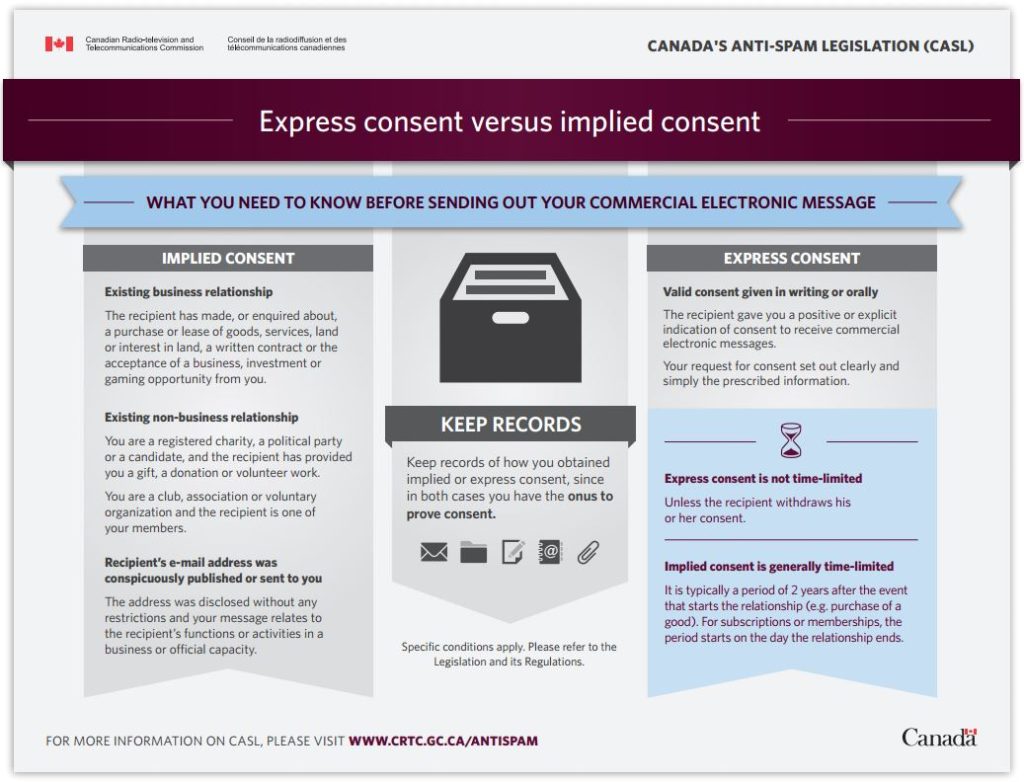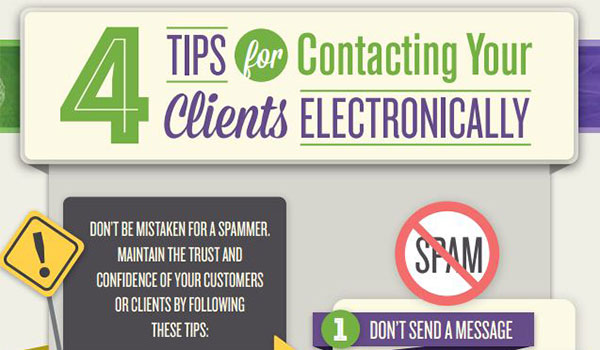What is the Canada’s Anti Spam Legislation?
Canada’s Anti-Spam Legislation (CASL) came into effect on July 1st, 2014. Long story short, it is a national effort to reduce the amount of spam and unwanted malware downloads in everyone’s email inbox and computer. However, in order to comply with this law, we’ve all had to read through it carefully, ask questions, and maybe even consult a lawyer for legal advice. You can check out how Canada’s anti-spam legislation applies to your business or organization in their video below:

What’s the Difference Between Explicit and Implied Consent?
Don’t know if the CASL law applies to you? Well, you can ask yourself one simple question. As the CASL website says, “if you are using electronic channels to promote or market your organization, products or services” then Canada’s new anti-spam law will affect your business. One of the main requirements for compliance with this law is obtaining consent from an individual or business before you can actually contact them by email.
Essentially, you can email anyone. But if they report you as spam, then it is your duty to provide proof that you have obtained consent from that individual. If you can’t provide proof, then you are not in a good place because it means you have no consent. And what happens after is that you may get penalized or sued. So before you think about emailing anyone, you need consent! What types of consent are there though? There’s two types: explicit and implied.
According to the CASL’s FAQ page, explicit consent is when “a person has clearly agreed (orally or in writing) to receive a commercial electronic message.” It is also good to know that explicit consent is not time-limited, which means you have consent until the recipient withdraws his or her consent. Your proof would essentially be that oral or written consent, which you need to either mark down or make a copy of, respectively!

So what if you don’t have written or oral consent from the individual? Well, then you have four different ways of getting implied consent. According to the CASL’s FAQ page again, there are a few forms of implied consent:
- Conspicuous Publication: The information (like an email) is published in plain sight, for example, on a website or in a trade magazine.
- Disclosure: The information is given to you, like when people give you their business card or address.
- Existing Business Relationship: The person has made a transaction, an inquiry, an application or a written contract for the purchase or barter of products, goods or services. So that basically means that they have a working business relationship with you already.
- Existing Non Business Relationship: The person is a member of your organization or has provided volunteer work, a donation or a gift. This means that you have to know the person through another type of existing working relationship.
Issues When Relying on Conspicuous Publication of Contact Info!
However, there is a special note that comes along with conspicuous publication and disclosure. When reading about implied consent, it states that “if people conspicuously publish their address or give it to you, then you have implied consent to send them messages related to their work. These are valuable forms of implied consent for business-to-business marketing since they allow cold calling, but only if the address as acquired legitimately and the message is relevant to the recipient.” So what does that mean? How do you know if the person you’re contacting is the right person? It’s not like everyone’s job duties and responsibilities are posted beside their name and email on a website!
On the CRTC (Canadian Radio-Television and Telecommunications Commission) Government Site it asks a very relevant question: “Can I send CEMs [fusion_builder_container hundred_percent=”yes” overflow=”visible”][fusion_builder_row][fusion_builder_column type=”1_1″ background_position=”left top” background_color=”” border_size=”” border_color=”” border_style=”solid” spacing=”yes” background_image=”” background_repeat=”no-repeat” padding=”” margin_top=”0px” margin_bottom=”0px” class=”” id=”” animation_type=”” animation_speed=”0.3″ animation_direction=”left” hide_on_mobile=”no” center_content=”no” min_height=”none”][Commercial Electronic Messages] to an email address I find online?” Their answer? “It depends on the situation. You can only rely on this conspicuous publication—or in other words, when someone posts or publishes their email address—when:
- There is no statement in connection with the address that the person does not want to receive CEMs at that address;
and - The content of your CEM is relevant to the recipient’s business, role, functions, or duties in a business or official capacity.”
Unsure of whether your email content is related to a recipient’s business, role, functions or duties in a business or official capacity? The CRTC gives an example here, but it doesn’t really apply to every scenario and it leaves you with more questions and more worries. In fact, if you Google for “conspicuous publication under CASL” and read some of the top links, like Barry Sookman, Blakes, Emond Harnden, and the Canadian Chamber of Commerce, it still doesn’t give you more examples of who you can send emails to if you find their email address online. They all state the same thing: to make sure your content is “relevant to the recipient’s business, role, functions, or duties in a business or official capacity.”
I’m Stuck and Confused! What Do I Do?
 As a new startup and small business, CryoDragon has had a lot of issues with understanding the CASL. We spent six months reading up on the CASL, sent out a bunch of emails to local lawyers, and in the end, we were given two options: (1) Pay a lot of money for legal advice or (2) Risk losing millions of dollars by not following the law or getting sued. Scary stuff!
As a new startup and small business, CryoDragon has had a lot of issues with understanding the CASL. We spent six months reading up on the CASL, sent out a bunch of emails to local lawyers, and in the end, we were given two options: (1) Pay a lot of money for legal advice or (2) Risk losing millions of dollars by not following the law or getting sued. Scary stuff!
As a startup with limited capital, it was hard for us to fork out hundreds or thousands of dollars just to be sure whether we could email someone. And we feared that if we sent an email to an address we found online, that we would be penalized and fined for sending a CEM.
So what did we do? We ended up going the old-school way and spent many hours every day handing out flyers and knocking on the doors of local businesses to try and get more clients. After 5 months, we only got less than a handful of clients, and we returned to reading up on the CASL.
From what we’ve read online, some legal entities suggest that you are not allowed to email an individual if they are not in the same field as you are. Others suggest that you are not allowed to email an individual if their role does not relate to the subject matter you are emailing about. But which one of these interpretations of the CASL is true? As a website and graphic design studio, we thought it was silly to only email individuals in the same field as we were in. If this were true, we’d be stuck with emailing website design companies and asking if they wanted a new website! We would get nowhere with our business. If the latter were true, then how would we know whether that person’s role dealt with managing or creating new websites for the company?
This time, we called and emailed both the CRTC and the Canadian Government to ask about the CASL. We presented them with our dilemma and asked them the simple questions of “how do I know who to email?” and “how do I know if their business role is relevant?”. We were finally able to speak to a man about this over the phone, and he shed a lot of light on all of our questions. In fact, we were so satisfied with his answers that we decided to write a post about it to help other businesses stuck in the same situation.
How Should You Send Emails to Potential Clients?
The main question for all businesses is whether there is a way to actually send emails to potential clients? What if you’re a new business and looking for new clients via implied consent? What if you’re an existing business looking for potential clients? Here are a few things you should keep in mind when sending out emails to potential clients with conspicuously published email addresses on their websites.
Always Keep a Record
- When you’re searching for a potential client, make sure you obtained their email address through their website or in print somewhere.
- Make sure that there is no CEM restriction for that contact person or email address. If they say they don’t want to receive commercial messages, you can’t email them. So, wherever you found this email address, take a screenshot of the webpage or keep the print version of wherever you found it. This would serve as proof that there was no restriction.
- Always keep a record of your email.
Information to be Inside Your CEM Email
- Your email should include your name, your position/title, the name of the company you work for, your email address, your phone number, a mailing address (either personal, work or PO box depending on who you’re emailing on behalf of), and a website address (URL) if you have one. Ensure that all your information is accurate for a minimum of 60 days after the day you send the message.
- Make sure you have a method for the recipient to unsubscribe or withdraw their consent, either by replying to the message or filling out a form. You’ll have 10 business days to unsubscribe the recipient from your mailing list.
- Add a clause or footnote at the end regarding your compliance with the CASL. The particular section about implied consent through a conspicuously published email address with no CEM restrictions is Section 10(9)(b) of the CASL.
- Your email should always start with an introduction to yourself. Also include information about your business services and products. Never lie, and make sure you indicate whether taxes are included or not if you’re listing a price.
- You must describe how your business services or products relates to the recipient’s business. Something like this: “I’m contacting you because our business is related to yours [in this way]”. If you can’t relate your business to the recipient’s business or business roles, then you are not allowed to email them.
- Indicate how you obtained the recipient’s email address. If you got their email off of their website, you can say something along the lines of: “We collected your email address off of your website” and make sure you have proof that there were no restrictions.
CryoDragon Inc. hopes that we have provided some help in terms of contacting potential new clients, and we wish you the best of luck in getting more business for your services! Feel free to comment below with opinions and questions!
And here’s our fine print! Remember that CryoDragon Inc. and its team members are not lawyers or legal representatives of a law firm. We have no desire to be a legal entity and should you need legal advice, that advice should be sought from your legal counsel. CryoDragon Inc. has spent an extensive amount of time researching Canada’s Anti-Spam Law (CASL) and even though we are confident in the information we have presented, this post should not be considered legal advice and was not published by legal professionals.






Great post! I’ve been searching for a post like this for literally years because no one really knows what the CASL is about and it seems like everyone has a different opinion. Glad to hear that you and your team were able to find some answers for all of us. Will share this post on other blogs.
Excellent site, thanks! I’ve bookmarked it 🙂
Thanks Nick!